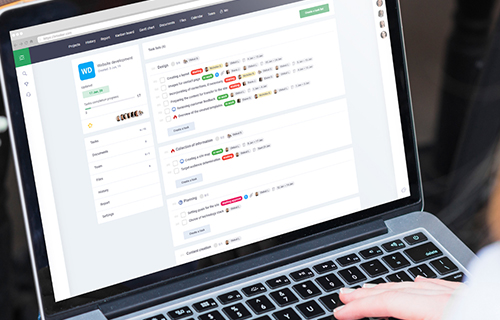Agile vs Scrum vs Kanban
The effectiveness of project activity greatly depends on the way it’s managed - for this purpose different project management methods can be applied. Their task lays in creation of best possible conditions for completing timely tasks and achieving the main set goal. Yet one still has to understand how one method differs from another one, what their individual strong points and particularities are. Because there cannot be a single management solution for all diverse projects - each activity has its own nature.
Kanban, Agile, Scrum are ones of the most used methods nowadays. These are not just collections of theoretical instructions, but handy and productive free tools for project management. Flexible management methodologies provide more freedom for conducting activities at the changing markets. As opposed to a conservative approach, that almost does not allow changes of current plans, such management methodologies give an opportunity to adjust the work almost at any stage. However Agile, Scrum and Kanban are based on separate principles, and only when taking into account their particularities one can select a really effective management system.
Agile - more than just a methodology
It would be completely wrong to say that Agile is a concrete methodology. This is an entire family of flexible management tools and principles. Some experts say that Agile is in fact a real way of life because it can be applied almost in all activity and tasks.
Initially Agile was worked out for the needs of IT industry, however with time its effectiveness was appreciated by the experts in other areas as well. The main idea of Agile lays in the fact that it’s not necessary to use initially set plans during the projects execution - much more important for the final result are:
- to base on dynamic conditions of internal and external environment;
- to ensure collaboration between the client and potential users;
- and to analyze their feedback.
This allows the performers to search for new solutions for the assigned tasks by avoiding strict lines and conditions.
When using the Agile tools the entire project is divided into several parts, which are completed in parallel by a certain group of specialists. Such a work principle ensures the following advantages:
- time saving by means of simultaneous development of several tasks;
- convenience for following the current results;
- effective distribution of workload between the performers;
- empowerment of specialists, etc.
Integration of Agile and its acceptance by the staff members ensures the possibility of turning a team of any size into one ‘body’, which makes the management easier and the activity more effective.
Scrum - a structural approach based on Agile
As mentioned, Agile is not a concrete methodology but a complex of management principles and conceptions. It’s a basis for other approaches, such as a widely used Scrum framework, and namely its principles are implemented in the project management software Intasker. Its key feature lays in a combination of traditional sequential approach and principles of flexible management which gives Scrum wider possibilities of use.
What is Agile Scrum common thing? When they are applied, the entire project is divided into several parts. A work process in Scrum is broken into separate sprints - these are work stages lasting from 1 up to 4 weeks and including a particular set of tasks. The result of completing each sprint is a part of the final result shown to the client. Afterwards the next sprint starts.
The advantage of using Scrum methodology is an opportunity to have a universal team - you won’t need to build a separate team for every new project. Additionally two persons take part in its completion:
- product owner - a mediator between performers and the client. The specialist on this position fulfills functions of a team manager;
- scrum master - they organize business processes, hold meetings of team members, solve generic issues, and control that Scrum principles are followed.
The key aspect of Scrum use is getting a concrete result after each sprint. It can be tested, shown to the client, and adjusted in case of any remarks.
Kanban: balance is the priority
This flexible methodology was created by the specialists of the Japanese company Toyota. The main principle of Kanban is keeping balance between diverse specialists who are in one working team. This allows to avoid situations when one part of the team works non-stop, while another one has no tasks.
Unlike in Scrum, Kanban management methodology does not divide the team members depending on their status - all team members have equal powers, there are no leaders, no managers there. Moreover, there are no universal sprints, a work process is broken into stages of completing clearly set tasks, e.g. ‘To plan’, ‘Doing’, ‘To verify’, ‘Done’, etc. They are recorded either online or on the board.
The average time of the task going through all the stages is estimated to analyze the work efficiency when applying Kanban. If the time matches the standard values or is less, this means the team worked seamlessly and efficiently. In case the delay emerged in some part of work, then it’s important to locate the reasons for this delay and to define how to optimize the work of a particular team member.
Kanban vs Scrum – what is the difference between them?
Both these frameworks have their own particularities and advantages, however it’s impossible to say which one is better. First of all, we need to keep in mind that both approaches are based on Agile principles. Moreover, as project management practice shows, it’s better to use possibilities of Scrum in one case, Kanban may be a better solution in another case, or even a combination of both methods may lead to the best result. Also, there may be a lot of situations when neither Scrum nor Kanban can be applied.
The key difference between these approaches lays in the duration of work cycles. While average sprints in Scrum last about 2-3 weeks, in Kanban it’s possible to add new tasks every single day. Therefore, Kanban is more flexible, but there may be no need to adjust the project so often.
The strong point of Scrum is its preliminary estimate of how time-consuming each task is - otherwise it’s impossible to define whether all tasks can be completed within the limited time of the sprint. Kanban does not provide such an estimate, the duration of the project stage completion is not a working condition in Kanban, but a criterion of its final estimate.
In general, Scrum is a more appropriate methodology for managing projects while they are being executed:
- it provides more control over the turnaround time;
- it has more opportunities for communication between team members;
- with the help of Scrum approach all team members can dive into work process.
Kanban can be used after project release, when there is feedback from the client and users. It’s very important at this stage to timely make changes and to have a chance to easily add new tasks at any time.
Agile vs Scrum
As noted above, Agile principles and philosophy are a basis for Scrum methodology. However this does not mean that Scrum is just an Agile duplicate. And below are given the main differences between them:
- different meanings of flexibility - Agile suggests to refuse strict initial plans and to stick to a possibility to timely respond to environment changing, and Scrum bases upon sprints system - tasks lists with strictly set turnaround time;
- Agile is not a methodology as it is, but a set of principles and a kind of philosophy which can be applied to all activity types. Scrum represents a specific framework that defines rules for execution of work.
In general, Scrum is a sort of, a component of the Agile flexible methods set and includes its specific terms. This reflects on the nature of their use - in most cases Agile and Scrum methodologies are applied in parallel.






